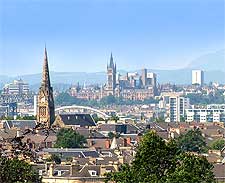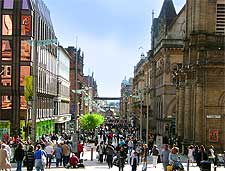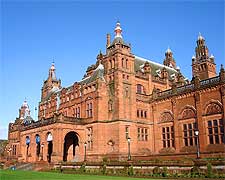Glasgow History Facts and Timeline
(Glasgow, Scotland, UK)

It's thought that Glasgow first grew up around a church that was founded by St. Mungo in the 6th century AD. It's difficult to imagine that the largest city in Scotland came from such modest beginnings.
At any rate, a village grew up around the church. By the 12th century, this episcopal settlement had grown to become one of the wealthiest in Scotland.
Medieval Origins in History
At some time around 1170, Glasgow became a burgh, thus freeing it from the constraints that had hampered its development so far. In the 1190s, the city was also permitted to hold an annual fair on what is now known as the Glasgow Green. At this point in the city's history, it was probably nothing more than a few main streets. In 1260, a community of Dominican friars set up here, providing care for the city's sick and infirm.
Perhaps a sign of the city's growing importance was the founding of the University of Glasgow in 1451. At that time, the university was very much tied in with the church. Lectures were held in the cathedral's crypt or in a nearby monastery. In 1492, the city was given its own archbishop.

From the 17th to the 19th Century
Glasgow was subjected to numerous setbacks during the 17th century, including being besieged several times. Nevertheless, the city began to prosper. Its wealth was mainly built on the tobacco, sugar and cotton trades. The new docks built at Port Glasgow, just down the River Clyde from the city centre, allowed goods to be imported and exported more easily.
Thanks to Glasgow's location on the west coast of Scotland, the city also benefited from the opening up of the new colonies in the Americas and West Indies. New prosperity brought new streets and building projects. In 1772, another bridge was built over the River Clyde and in 1775, work on the Royal Exchange was completed.
In the 19th century, Glasgow came to rely on its heavy industries, including steel, coal and shipbuilding. Nearby sources of iron ore, coal and limestone meant that the city was perfectly located as a centre for new industry. Little wonder that, for the Victorians, this was acknowledged as 'the second city of the British Empire'. By 1835, Glasgow was producing half the tonnage of all British steam ships. The arrival of steam trains meant that even more goods could be transported to and from the city.
A thriving textile industry sprang up along with steam-driven mills. Of course, whilst such industrial endeavour generated vast sums of wealth for the city's businessmen, it did little for ordinary Glaswegians. Cheap housing to accommodate workers led to the city having a reputation for some of the worst slums in the whole country.

Modern Times in the City
During World War One and World War Two, Glasgow became a centre for the manufacturing of ships and armaments. It also became a prime target for German bombing raids. Such raids destroyed much of Glasgow's slum housing. However, post-war housing development did little to right the situation. It was during this phase of the city's history that we see the construction of such infamous housing estates as the Gorbals.
From the 1950s on, the city's fortunes went into decline. Stiff competition from overseas and a lack of investment in the city led to high unemployment and poor conditions for those who lived here. By the 1970s, urban decay was perhaps at its worst. Then, in 1990, Glasgow's circumstances changed quite dramatically. It was named European City of Culture and what followed was a period of massive investment in the city. It produced such developments as those found on the waterfront, leading to Glasgow being named the UK City of Architecture and Design in 1999.
 It's thought that Glasgow first grew up around a church that was founded by St. Mungo in the 6th century AD. It's difficult to imagine that the largest city in Scotland came from such modest beginnings.
It's thought that Glasgow first grew up around a church that was founded by St. Mungo in the 6th century AD. It's difficult to imagine that the largest city in Scotland came from such modest beginnings.
